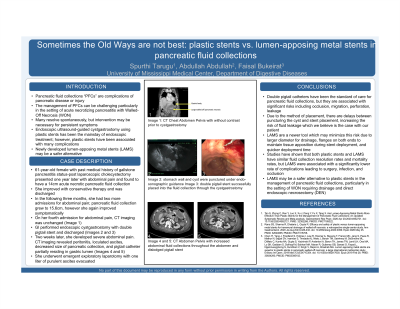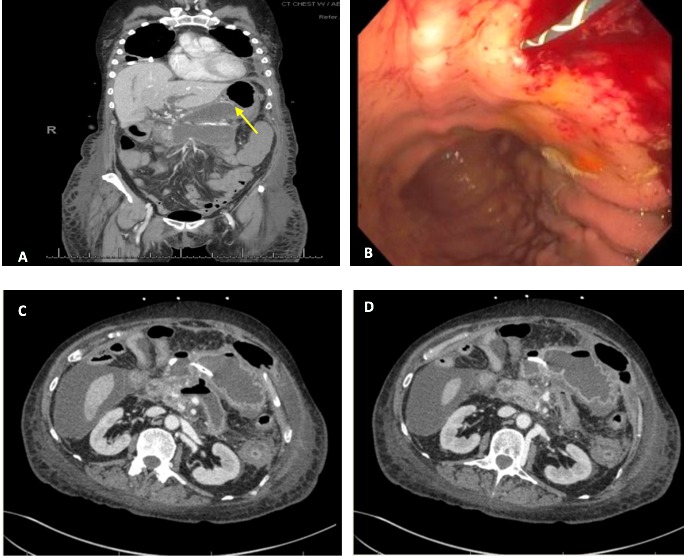Tuesday Poster Session
Category: Biliary/Pancreas
P3576 - Sometimes the Old Ways Are Not Best: Plastic Stents vs Lumen-Apposing Metal Stents in Pancreatic Fluid Collections
Tuesday, October 29, 2024
10:30 AM - 4:00 PM ET
Location: Exhibit Hall E

Has Audio
- ST
Spurthi Tarugu, MD
University of Mississippi Medical Center, MS
Presenting Author(s)
Spurthi Tarugu, MD1, Abdullah Abdullah, MD1, Faisal A.. Bukeirat, MD2
1University of Mississippi Medical Center, Madison, MS; 2UMMC, Jackson, MS
Introduction:
Pancreatic fluid collections “PFCs” are complications of pancreatic disease or injury. The management of PFCs can be challenging particularly in the setting of acute necrotizing pancreatitis with Walled-Off Necrosis (WON).
While many resolve spontaneously, intervention may be necessary for persistent symptoms. Endoscopic ultrasound-guided cystgastrostomy using plastic stents has been the mainstay of endoscopic treatment; however, plastic stents have been associated with many complications. Newly developed lumen-apposing metal stents (LAMS) may be a safer alternative.
Case Description/Methods: A 61-year-old female with past medical history of gallstone pancreatitis status-post laparoscopic cholecystectomy in 2022 presented one year later with abdominal pain and found to have a 14cm acute necrotic pancreatic fluid collection. She improved with conservative therapy and was discharged. In the following three months, she had two more admissions for abdominal pain; pancreatic fluid collection grew to 15.6cm, however she again improved symptomatically. On her fourth admission for abdominal pain, CT imaging was unchanged. GI performed endoscopic cystgastrostomy with double pigtail stent and discharged. Two weeks later, she developed severe abdominal pain. CT imaging revealed peritonitis, loculated ascites, decreased size of pancreatic fluid collection, and pigtail catheter partially residing in gastric lumen. She underwent emergent exploratory laparotomy with one liter of purulent ascites evacuated.
Discussion: Double pigtail catheters have been standard of care for PFCs, but they are associated with significant risks including occlusion, migration, perforation, and leakage. Due to the method of placement, there are delays between puncturing the cyst and stent placement, increasing the risk of fluid leakage which we believe is the case with our patient. LAMS are a newer tool which may minimize this risk. LAMS have a large diameter for drainage, flanges on both ends to maintain tissue apposition during stent deployment, and quicker deployment time. Studies have shown that both plastic stents and LAMS have similar fluid collection resolution rates and mortality rates, but LAMS were associated with a significantly lower rate of infection, occlusion, and complications leading to surgery. As such, LAMS may be a safer alternative to plastic stents in the management of pancreatic fluid collections, particularly in the setting of WON requiring drainage and direct endoscopic necrosectomy (DEN).

Disclosures:
Spurthi Tarugu, MD1, Abdullah Abdullah, MD1, Faisal A.. Bukeirat, MD2. P3576 - Sometimes the Old Ways Are Not Best: Plastic Stents vs Lumen-Apposing Metal Stents in Pancreatic Fluid Collections, ACG 2024 Annual Scientific Meeting Abstracts. Philadelphia, PA: American College of Gastroenterology.
1University of Mississippi Medical Center, Madison, MS; 2UMMC, Jackson, MS
Introduction:
Pancreatic fluid collections “PFCs” are complications of pancreatic disease or injury. The management of PFCs can be challenging particularly in the setting of acute necrotizing pancreatitis with Walled-Off Necrosis (WON).
While many resolve spontaneously, intervention may be necessary for persistent symptoms. Endoscopic ultrasound-guided cystgastrostomy using plastic stents has been the mainstay of endoscopic treatment; however, plastic stents have been associated with many complications. Newly developed lumen-apposing metal stents (LAMS) may be a safer alternative.
Case Description/Methods: A 61-year-old female with past medical history of gallstone pancreatitis status-post laparoscopic cholecystectomy in 2022 presented one year later with abdominal pain and found to have a 14cm acute necrotic pancreatic fluid collection. She improved with conservative therapy and was discharged. In the following three months, she had two more admissions for abdominal pain; pancreatic fluid collection grew to 15.6cm, however she again improved symptomatically. On her fourth admission for abdominal pain, CT imaging was unchanged. GI performed endoscopic cystgastrostomy with double pigtail stent and discharged. Two weeks later, she developed severe abdominal pain. CT imaging revealed peritonitis, loculated ascites, decreased size of pancreatic fluid collection, and pigtail catheter partially residing in gastric lumen. She underwent emergent exploratory laparotomy with one liter of purulent ascites evacuated.
Discussion: Double pigtail catheters have been standard of care for PFCs, but they are associated with significant risks including occlusion, migration, perforation, and leakage. Due to the method of placement, there are delays between puncturing the cyst and stent placement, increasing the risk of fluid leakage which we believe is the case with our patient. LAMS are a newer tool which may minimize this risk. LAMS have a large diameter for drainage, flanges on both ends to maintain tissue apposition during stent deployment, and quicker deployment time. Studies have shown that both plastic stents and LAMS have similar fluid collection resolution rates and mortality rates, but LAMS were associated with a significantly lower rate of infection, occlusion, and complications leading to surgery. As such, LAMS may be a safer alternative to plastic stents in the management of pancreatic fluid collections, particularly in the setting of WON requiring drainage and direct endoscopic necrosectomy (DEN).

Figure: Image A: CT Chest Abdomen Pelvis with and without contrast on 1/2/2024 prior to cystgastrostomy demonstrating large walled off pancreatic necrosis in close relation to gastric body. Image B: endoscopic imaging with double pigtail stent in place in gastric body. Images C and D: CT Abdomen Pelvis demonstrating loculated ascites and double pigtail stent in gastric antrum
Disclosures:
Spurthi Tarugu indicated no relevant financial relationships.
Abdullah Abdullah indicated no relevant financial relationships.
Faisal Bukeirat indicated no relevant financial relationships.
Spurthi Tarugu, MD1, Abdullah Abdullah, MD1, Faisal A.. Bukeirat, MD2. P3576 - Sometimes the Old Ways Are Not Best: Plastic Stents vs Lumen-Apposing Metal Stents in Pancreatic Fluid Collections, ACG 2024 Annual Scientific Meeting Abstracts. Philadelphia, PA: American College of Gastroenterology.
